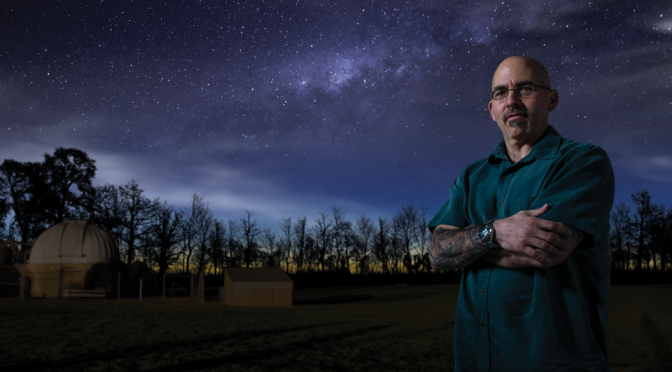Our cosmic address is one galaxy, the Milky Way, but there’s a universe teeming with a zoo of 100 billion galaxies. UMKC Associate Professor of Physics and Astronomy Daniel H. McIntosh, Ph.D., is trying to find out how that happened.
“We know that soon after the Big Bang there were ZERO galaxies,” he says. “We also know the first proto-galaxies were tiny compared to our home galaxy. So how did we get to where we are now?”
Galaxies are huge collections of normal matter, stars, gas and dust made out of atoms like people. They are held together by gravity that astronomers believe is mostly from dark matter, McIntosh described.
“As the universe ages, expansion and gravity accentuate regions of greater and lesser dark matter density, thereby creating a ‘cosmic web’ of galactic beacons mapping the universe in both time and space,” he says. “We’re mapping cosmic history when we study distant galaxies.”
As a basic researcher, McIntosh likes to answer questions and considers himself an extragalactic astronomer and a galaxy demographer. The data he collects and his interpretations provide important new tests for current and future theoretical models of galaxy formation.
“The more we learn, the more questions we have,” he says. “This is why doing science is so fun!”
Specifically, McIntosh wants to know how galaxies grow. By grow, he means learning how galaxies add more stars. Astronomers understand that one way galaxies grow is when they collide and merge together; it’s the most spectacular growth mechanism, but not the only. He said the question is if it is the most important growth mechanism. So he is looking for galaxies getting ready to merge or that have recently merged. Galaxies are the only places that stars form. If there’s no star production, McIntosh said there’s no planets and no chemistry for life.
The Galaxy Evolution Group, which McIntosh founded in 2009, focuses on the formation and evolution of galaxies.“The current model is that all galaxies start off as strong producers of stars, but over time a sort of ‘galaxy capitalism’ occurs in which the most heavy-weight galaxies, those with the most stars, do not produce stars themselves,” McIntosh says. “Yet, they appear to grow the fastest while the star-forming galaxies do all of the work but do not grow in terms of stellar wealth. This is an intriguing mystery.”
McIntosh is also co-investigator and collaborates on the Cosmic Assembly Near-infrared Deep Extragalactic Legacy Survey. CANDELS is the largest Hubble Space Telescope survey ever of distant galaxies.
Telescopes on Earth and in space measure different wavelengths of light emitted by faraway galaxies.
“Light has a wonderful property. Its speed is constant. That effectively means that our telescopes are like time machines because it takes millions or billions of years for light emitted by distant galaxies to reach Earth and deliver information about the state of these objects from a time when the universe was much younger,” McIntosh says.
“The tricky part is due to the fact that the expansion of the universe shifts the light we observe to redder wavelengths. This makes it more difficult for us to observe galaxies from different times in the past at the same wavelengths of light.”
High-tech instruments, such as the Hubble Space Telescope, have changed how we see the universe. McIntosh said Hubble’s optics, science instruments and spacecraft systems work together to capture a wider range of wavelengths from the cosmos than we see with our eyes, convert it into digital data and transmit it back to Earth.
“Now we can see the detail in faraway galaxies that we could only see in near galaxies. For the first time, we can study galaxy populations from the early universe and compare them to current galaxies,” McIntosh says. “This is really cutting edge.”

